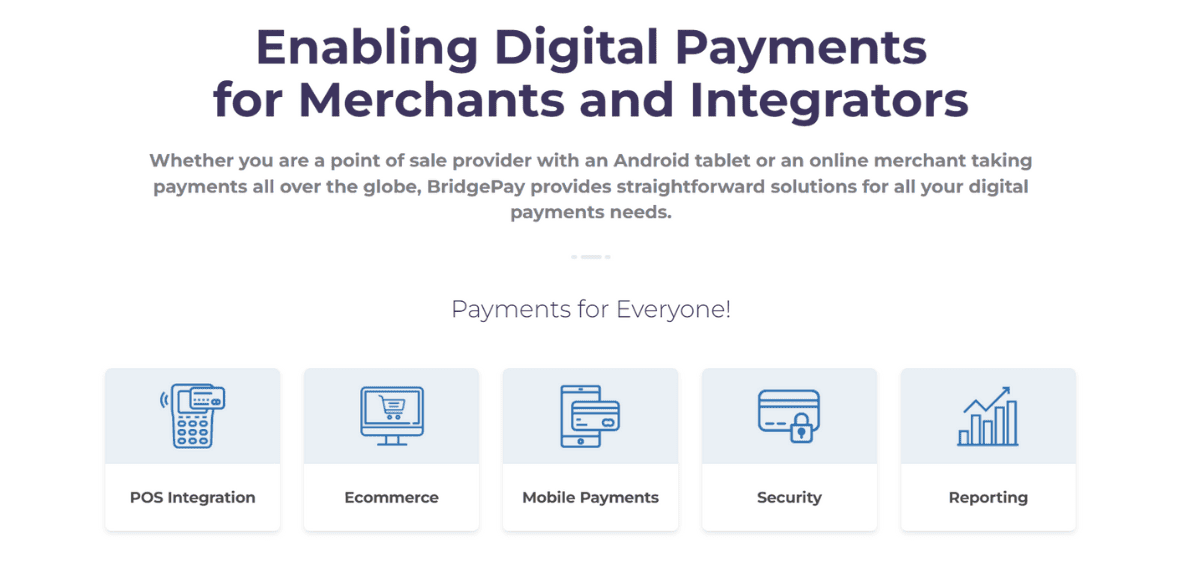
BridgePay Network Solutions Review
- 27th Oct, 2025
- | By Linda Mae
- | Reviews
BridgePay Network Solutions is a payment technology provider that connects merchants, processors, and software developers through a unified, secure gateway. Founded with the goal of simplifying complex payment integrations, BridgePay has become known for its flexibility and strong emphasis on compliance. The company enables businesses to accept and manage transactions across multiple channels; online, in-store, and mobile; without being locked into a single processor or platform. Its solutions are widely used by ISVs, ISOs, and merchants seeking a more transparent approach to payment processing. Lets read more about BridgePay Network Solutions Review.
Over the years, BridgePay has evolved from a basic gateway provider into a versatile payments ecosystem. It offers APIs, SDKs, and white-label tools that allow partners to build customized payment experiences. By bridging the gap between technology and financial services, the company positions itself as an enabler rather than a processor. This means merchants retain the freedom to choose their acquiring partners while relying on BridgePay’s secure transaction layer. With its focus on security, scalability, and partner collaboration, it stands as a trusted intermediary in the growing world of digital commerce.
Table of Contents
ToggleCore Mission and Market Position | BridgePay Network Solutions Review
BridgePay’s core goal is to simplify payment acceptance while giving its users flexibility. Instead of competing with the big processors, it acts as a neutral connector between merchants and banks. This allows it to focus on technology innovation; particularly around integration and data management; rather than traditional merchant acquiring. The company’s platform gives developers and partners a single interface for transaction routing, reporting and compliance regardless of the underlying processor.
In the payment technology landscape BridgePay fills a niche similar to middleware; enabling existing systems to talk to each other securely and efficiently. It’s perfect for software companies and ISVs that want to add payment capabilities without taking on the full regulatory or operational burden of payment processing. BridgePay’s market positioning is “partner first”; it wants to empower those who build and resell payment enabled software not compete with them. By offering stable APIs, tokenization tools and multi-processor connectivity BridgePay reduces friction in an industry divided by incompatible systems. This collaborative role gives BridgePay an advantage in a fragmented and rapidly changing market.
Overview of BridgePay’s Payment Gateway
At the heart of BridgePay’s offerings lies its robust payment gateway; a technology layer that routes, encrypts, and authorizes payment data between merchants and processors. The gateway supports a variety of transaction types, including credit and debit cards, ACH, recurring billing, and mobile wallet payments. It is built to handle both card-present and card-not-present environments, making it suitable for e-commerce retailers, hospitality businesses, and service providers alike.
One of the key benefits of BridgePay’s gateway is its processor neutrality. Merchants are not tied to a single acquiring bank, which provides flexibility to negotiate rates or switch providers without changing their integration. The gateway also incorporates advanced fraud-prevention features, ensuring that transaction security is upheld from authorization to settlement. Its cloud-based infrastructure delivers consistent uptime and performance, supporting high-volume businesses as well as small operators.
Additionally, BridgePay’s gateway integrates easily with shopping carts, POS systems, and mobile apps through its developer-friendly APIs. Merchants gain a unified view of their payments across locations and channels, enabling more accurate reporting and reconciliation. Overall, BridgePay’s payment gateway functions as a scalable and secure backbone for modern commerce.
Integration Capabilities and Developer Tools
BridgePay has a developer-first approach. We have well documented APIs, SDKs and sandboxes to get you up and running with a wide range of systems. Developers can embed payment functionality into web, desktop and mobile applications using RESTful APIs and standard libraries. This reduces integration time and lets 3rd party vendors control the user experience of their software.
For businesses using point of sale systems, it has semi-integrated solutions that isolate sensitive card data from the merchant’s network; reducing PCI scope while maintaining a seamless checkout flow. We also support tokenization and stored credential features to help developers manage recurring and subscription billing safely.
BridgePay’s integration options aren’t limited to in-house builds. We support many leading shopping carts, ERP systems and payment processors so developers can connect multiple services through one gateway. Our technical documentation is clear and easy to find and the developer portal has sample code, FAQs and testing tools to make onboarding easier for our partners. BridgePay’s open architecture makes us a great partner for software developers looking to add payment capabilities without starting from scratch.

Security Features and Compliance Standards
Security lies at the core of BridgePay’s infrastructure. The platform is fully PCI DSS Level 1 compliant, which is the highest standard for payment data protection. It uses P2PE and tokenization to ensure that sensitive cardholder data never passes through merchant systems in plain text. These layers of protection minimize the risk of data breaches and unauthorized access.
It also employs robust fraud-management tools that detect unusual transaction patterns and alert merchants to potential threats. Features like CVV verification, AVS, and velocity checking provide additional layers of defense. The company routinely undergoes audits and vulnerability scans to maintain compliance with evolving industry standards.
For businesses concerned about compliance, BridgePay offers guidance and documentation to help merchants understand their security responsibilities. Its semi-integrated payment models further reduce PCI scope by isolating sensitive data from merchant environments. Combined with tokenized storage for recurring payments, these measures reflect a strong security-first mindset. While no system can eliminate all risks, BridgePay’s consistent focus on compliance and encryption places it among the more security-conscious providers in the industry.
Transaction Management and Reporting
BridgePay gives merchants a central dashboard to see and manage transactions in real time. This web based reporting portal allows you to view transaction history, authorizations, settlements, refunds and chargebacks and export data for accounting purposes. The reporting is designed to be easy to read so you can filter by date, card type, terminal or location.
Advanced analytics give you insight into sales patterns and customer behavior. You can see peak times, recurring customers, and potential declines or errors. This helps with operational efficiency and decision making. For multi location businesses BridgePay’s reporting consolidates data from all locations into one interface so you have visibility across the entire business.
The system also has batch management and automated reconciliation with processors. You can set up alerts and daily summaries to stay on top of key metrics. Overall BridgePay’s transaction management tools balance ease of use with depth so both technical and non technical users have control over their payment data. While the interface could use some more modern visualization tools it’s reliable and functional for most businesses.
Supported Payment Methods and Channels
BridgePay’s technology supports a wide range of payment options, reflecting the diverse needs of today’s commerce landscape. Merchants can process all major credit and debit cards, including Visa, Mastercard, Discover, and American Express. Additionally, the platform supports ACH and eCheck payments for businesses dealing in B2B or subscription transactions.
Beyond traditional cards, it accommodates mobile and digital wallet payments such as Apple Pay and Google Pay, enabling smoother experiences at the point of sale. Its recurring billing functionality supports membership models, utilities, and service-based businesses that depend on automatic renewals.
A notable strength of BridgePay lies in its omnichannel approach. Merchants can manage both in-person and online transactions through one system. This unified structure helps simplify reconciliation and customer support. For e-commerce platforms, it offers plug-ins for popular shopping carts, while brick-and-mortar businesses benefit from POS integrations. The flexibility extends to mobile payments as well, giving field service providers and mobile merchants the same access to secure processing as storefront operations. BridgePay’s commitment to multi-channel compatibility positions it as a comprehensive solution for modern businesses.
BridgePay for ISOs, Developers, and Partners
BridgePay’s partner-oriented business model distinguishes it from many payment gateways. It caters specifically to ISVs, ISOs, and VARs who want to deliver payment capabilities under their own brand. Through its white-label program, partners can leverage BridgePay’s technology infrastructure while maintaining complete control over branding, pricing, and merchant relationships.
For ISOs, the platform simplifies merchant onboarding, transaction routing, and revenue tracking. BridgePay provides APIs for boarding automation and access to multi-merchant management dashboards. Developers can embed payments directly into their software products using BridgePay’s secure API suite, reducing the time and cost required to become payment-enabled.
Partners also benefit from BridgePay’s processor-agnostic architecture, allowing them to connect with multiple acquiring banks and gateways. This flexibility ensures that they can serve a broader range of merchants without re-engineering their integrations. BridgePay’s partner support includes technical documentation, co-marketing materials, and integration consulting. Overall, the platform’s partnership ecosystem helps other payment providers and developers extend their market reach without compromising security or scalability.
Hardware and POS Compatibility
BridgePay supports a variety of hardware options for card-present transactions, ensuring compatibility with leading POS device manufacturers such as Ingenico, PAX, and Verifone. Its semi-integrated approach allows terminals to communicate directly with the gateway while isolating card data from the merchant’s network, improving both security and compliance.
This flexibility enables businesses to choose hardware that fits their environment; whether countertop, mobile, or unattended terminals. For mobile merchants, BridgePay supports wireless and Bluetooth devices that integrate seamlessly with smartphones and tablets. The platform’s device management tools simplify updates and configuration, allowing merchants to maintain consistent performance across locations.
BridgePay also supports EMV chip and contactless payments, keeping businesses aligned with current security and consumer expectations. The system’s design ensures that merchants can continue using existing hardware investments while adding new devices as their operations grow. While it may not manufacture its own terminals, its broad compatibility ensures that businesses can adopt the solution without significant infrastructure changes, making it suitable for both small retailers and large enterprises.

Pricing and Fee Transparency
BridgePay’s pricing model is not publicly disclosed on its website, which is common among technology-driven gateway providers that operate through partners and resellers. Pricing typically depends on factors such as transaction volume, integration type, and the acquiring processor involved. Businesses often negotiate costs through their payment partners rather than BridgePay directly.
That said, BridgePay’s structure tends to favor flexibility. Merchants benefit from the ability to connect with multiple processors, potentially achieving better rates through competition. For ISOs and developers, the white-label arrangement provides room to set their own pricing models, enabling them to design competitive merchant offerings.
While the lack of transparent public pricing may deter very small merchants seeking instant comparisons, the customizable structure suits larger organizations that require tailored contracts. BridgePay’s focus on technology delivery rather than direct processing keeps its cost base lean, which can translate into favorable pricing through partners. Prospective clients are encouraged to consult a BridgePay reseller or ISO partner to receive detailed cost breakdowns and to ensure alignment with their transaction volumes and support needs.
Customer Support and Technical Assistance
BridgePay offers multiple layers of customer and technical support, including email, phone, and online resources. Its documentation portal is particularly useful for developers integrating the gateway, with code samples and troubleshooting guidance. For merchants, BridgePay provides onboarding assistance, system walkthroughs, and operational support to ensure smooth implementation.
The support quality is generally considered responsive, though the experience can vary depending on whether the client works directly with BridgePay or through a reseller. Many partners handle first-line merchant inquiries, while BridgePay focuses on deeper technical or integration issues. The company’s U.S.-based support team has a reputation for professionalism and technical expertise, especially in resolving gateway connectivity and API issues.
It also maintains an active knowledge base with user guides and integration tips. However, unlike larger processors offering 24/7 live chat, availability may depend on contractual arrangements. Still, most users find the support experience reliable, especially during integration and deployment phases. For developers and partners seeking a technically competent yet approachable support team, BridgePay delivers consistent value.
Pros of Using BridgePay
BridgePay offers several notable strengths that make it a competitive option in the payments industry. Its processor-agnostic approach gives merchants and partners freedom to choose or switch processors without major disruptions. This flexibility helps reduce vendor lock-in and enables cost optimization over time.
The company’s emphasis on security and compliance ensures that merchants can meet industry standards without excessive technical overhead. BridgePay’s developer-friendly APIs and white-label programs make it ideal for ISVs and resellers looking to integrate or resell payment technology. Its omnichannel capabilities, spanning online, in-store, and mobile; allow merchants to unify their operations under one reporting and management system.
BridgePay’s platform stability, documentation quality, and scalability also stand out. Businesses that prioritize control and long-term adaptability find these features particularly valuable. While it may not provide its own merchant accounts, its neutral technology backbone and partnership model deliver a strong foundation for payment innovation. In essence, BridgePay’s greatest advantage lies in giving businesses choice and control over their payment infrastructure.
Cons or Limitations
Despite its many strengths, BridgePay is not without limitations. The most significant drawback is the lack of public pricing transparency, which can make cost estimation difficult for small businesses. Because BridgePay often works through ISOs and partners, customer support experiences can vary based on who manages the account.
Another consideration is the technical nature of its integration. While developer resources are extensive, non-technical merchants may require professional help to complete setup and customization. For those seeking quick, plug-and-play payment solutions, it may feel more complex compared to turnkey options.
Additionally, some users report that the reporting interface could be more modern or customizable. The company’s focus on back-end technology sometimes means fewer aesthetic enhancements on the merchant dashboard. International capabilities are also limited, as BridgePay primarily serves North America.
Overall, these limitations are manageable for businesses with a solid technical foundation or access to a development partner. BridgePay’s trade-offs are primarily the result of its flexible, partner-driven model; which favors scalability and customization over simplicity.
Ideal Business Types and Use Cases
It is particularly well-suited for software developers, ISVs, and ISOs who want to integrate or resell payment solutions under their own brand. It serves as a versatile backbone for payment applications across retail, hospitality, healthcare, and service industries. Multi-location merchants and franchise operators benefit from its centralized reporting and flexible processor options.
E-commerce businesses that value data control and security also find BridgePay appealing. Its tokenization and recurring billing tools make it ideal for subscription-based services or SaaS products. For brick-and-mortar retailers, BridgePay’s POS compatibility ensures smooth, secure in-store transactions without the complexity of separate systems.
Startups with technical teams can use BridgePay to build tailored payment experiences, while established enterprises can leverage it for integration with existing ERP or CRM software. Even though it may not cater perfectly to micro-businesses seeking one-click setup, BridgePay’s scalability makes it a long-term solution for growing organizations. In essence, the platform is designed for businesses that view payments as a strategic component of their operations rather than a simple utility.
FAQs
Q1. Is BridgePay Network Solutions suitable for small businesses?
It can support small businesses that have access to technical resources or work through an ISO partner. However, those seeking plug-and-play simplicity may find it more technical than direct processors.
Q2. Does BridgePay support international transactions?
It primarily serves U.S.-based merchants, though select partners may enable limited international processing through specific acquiring banks. It is best suited for North American operations.
Q3. How secure are BridgePay’s payment systems?
It maintains PCI DSS Level 1 compliance, uses tokenization and end-to-end encryption, and implements fraud-detection tools to ensure high standards of payment security and data protection.
